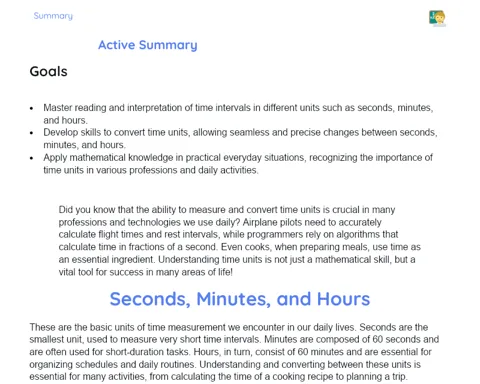Quadrilateral: Rhombus | Active Summary
Objectives
1. Identify and describe the geometric properties of a rhombus, focusing on its characteristic of having all sides equal.
2. Calculate the measures of the sides and internal angles of a rhombus.
3. Solve practical problems that involve the use of rhombuses, applying geometric properties in various contexts.
Contextualization
Did you know that the rhombus is not just a geometric figure, but also a very common element in various types of design and art? For example, the pattern of tiles in some sidewalks or the shape of many kites are rhombuses. This figure is not only visually beautiful, but its geometric properties, such as symmetry and equal sides, make it extremely practical for applications in engineering, architecture, and even in video games to represent objects in perspective.
Important Topics
Geometric Properties of the Rhombus
A rhombus is a quadrilateral with all sides of equal length, which implies that the opposite angles are equal. Additionally, its diagonal angles are perpendicular to each other and divide the rhombus into four congruent triangles. These properties make the rhombus a symmetrical figure and very useful in various practical and artistic applications.
-
All sides of the rhombus are equal, which facilitates the calculation and execution of projects requiring symmetry and regularity.
-
The internal angles of the rhombus are always equal, which helps in the construction of shapes that require precision, such as in jewelry making and architecture.
-
The diagonals of a rhombus are perpendicular and bisect each other, which is crucial for determining measures in projects requiring precision, like building structures or creating artistic patterns.
Calculation of Area and Perimeter
To calculate the area of a rhombus, simply multiply the lengths of its diagonals and divide by two. The perimeter of a rhombus is the sum of the lengths of its four sides. These formulas are essential for the practical application of the rhombus in construction, design, and engineering projects.
-
Area = (d1 * d2) / 2, where d1 and d2 are the diagonals of the rhombus. This formula is fundamental for determining the amount of material required in paving and coating projects.
-
Perimeter = 4 * side. Knowing how to calculate the perimeter is crucial for sizing fences or frames in design and construction projects.
-
Understanding and applying these formulas helps students visualize mathematics in action, making learning more practical and meaningful.
Practical Applications of the Rhombus
The rhombus is not just a mathematical concept, but a figure that finds applications in various fields, such as jewelry design, civil engineering, and art. Its symmetry and geometric properties make it ideal for creating visually appealing and functional patterns.
-
In engineering, rhombuses are used in structures such as bridges and towers due to their ability to distribute weight evenly and efficiently.
-
In jewelry design, rhombuses are often used to create diamond cutting patterns or in assembling pieces for necklaces and earrings.
-
In art, the rhombus is a popular shape in tile patterns, fabrics, and other decorative applications, due to its ability to create visually interesting designs through repetitions and variations.
Key Terms
-
Rhombus: A quadrilateral with all sides of equal length and equal opposite angles. Its diagonals are perpendicular and bisect each other.
-
Diagonals: Segments that connect non-adjacent vertices in a polygon.
-
Perimeter: The sum of the lengths of all sides of a polygon.
-
Area: Measure of surface, calculated by multiplying the base by the height for rectangular shapes, and base times height for triangles and parallelograms.
To Reflect
-
How do you think the symmetry of a rhombus can influence the aesthetics of an architectural project?
-
Think of an object in your everyday life that can be described geometrically as a rhombus. How do its geometric properties affect its function?
-
In what way can understanding the properties of rhombuses help in your daily life or future career?
Important Conclusions
-
We explored the unique properties of the rhombus, a quadrilateral with equal sides and congruent opposite angles, whose diagonals are perpendicular and bisect each other. These characteristics make it not only an interesting figure for mathematical study, but also essential in practical applications such as engineering and design.
-
We learned how to calculate the area and perimeter of a rhombus, fundamental skills that can be applied in construction projects, art, and other creative fields.
-
We discussed various applications of the rhombus in the real world, from structural engineering to jewelry design and art, highlighting the importance of understanding geometric properties to solve problems and create functional and aesthetically pleasing designs.
To Exercise Knowledge
- Draw a rhombus on a sheet of paper and calculate its measures: sides, internal angles, diagonals, area, and perimeter. 2. Create a rhombus pattern for wallpaper, using different colors for the sides and diagonals, and calculate how many rhombuses are needed to cover a specific area. 3. Design a small rhombus-shaped garden, considering the layout of plants and paths, and calculate the amount of material needed to pave the paths with rhombus-shaped tiles.
Challenge
Geometric Park Challenge: Imagine you are tasked with designing a small park on a limited budget. The park must have at least three paved areas in the shape of a rhombus. You need to calculate the exact amount of material needed for each area, based on the provided measurements. Present your project with the calculations and justify your design choices.
Study Tips
-
Use visual resources, such as drawings or geometric models, to help visualize the properties of the rhombus and solve problems more concretely.
-
Regularly practice calculating the area and perimeter of different geometric figures, including the rhombus, to improve your ability to apply mathematical formulas in various contexts.
-
Discuss with your classmates or teachers about potential practical applications of rhombuses and other geometric figures in the real world, to enhance understanding and motivation in studying geometry.



